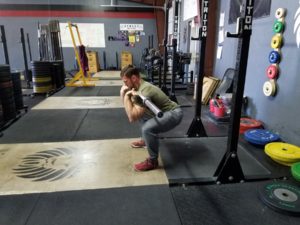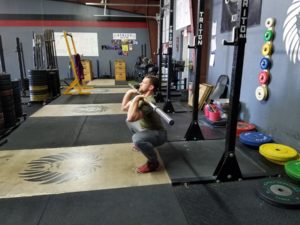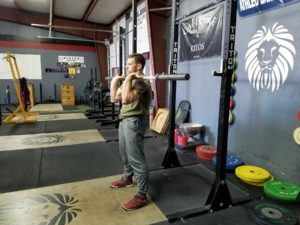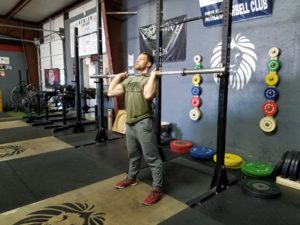By: Coach Joshua Jericho Littauer
You will discover with many weightlifting movements, there is no real cookie cutter way of doing things, however, there are principles to be followed that can be applied to each individual case. The front squat is no different. There are in fact dozens of factors that go into properly front squatting and improving not only load capacity but also improving mechanics. This brief article will discuss why the front squat is used, a few major principles and faults, and how to apply it to your training.
Why Front Squat?
This is not an uncommon question, especially when in many strength circles the back squat is considered the king of all squats (more on this another time). The front squat seems to get neglected by athletes for several reasons; poor mobility, discomfort, or lack of proper coaching on how to front squat are all factors in its scarcity in programs. However, in order to maintain a well rounded squatting profile and proper structural balance it is important to incorporate the front squat.
The major differences in the front and back squat can be found in the position of the barbell on the athlete’s frontal plane. We will consider the frontal plane of the athlete to be the center of mass from front to back. This plane is what determines the angles and degrees of freedom with which the torso, femur, and fibula are able to move. The slight change in position of the bar from sitting directly over the spinal column to sitting across the clavicle makes some very distinct changes in position and effect of the squat itself.
By placing the bar across the clavicle (here on called the front rack position), it forces the athlete to stay in a more upright position throughout the squat. This puts greater stress on the athlete’s trunk tension and position. By adding stress to the core by pulling the torso forward, the front squat becomes a significant teacher of internal core pressure and balance throughout the squat.
As previously mentioned, the front squat requires a more upright torso than that of the back squat, which by doing so tends to load the anterior greater than posterior. By doing so, the loading also tends to be less than that of the back squat. This allows for greater variation in the load schemes as well as the direct impact on the central nervous system (CNS).
It is important therefore to incorporate the front squat into your strength program to keep a well balanced position, and gain strength in multiple variations in the squat.
Common Faults
This is where mobility comes into play. There are several big categories of mobility that lend themselves to success in the front squat. The first being range of motion in the ankles that prevents an athlete from achieving a stable bottom position in the squat.



 The other mobility issue that causes problems in positioning in the front squat is shoulder or upper thoracic mobility. With tight shoulders and upper thoracic it becomes difficult to maintain the elbow position parallel to the floor.
The other mobility issue that causes problems in positioning in the front squat is shoulder or upper thoracic mobility. With tight shoulders and upper thoracic it becomes difficult to maintain the elbow position parallel to the floor.
If both of these mobility hindrances exist than it is common to see the athlete’s chest dump forward as they progress out of the bottom of the squat. Other common issues in the front squat include, knees coming together, lower back rounding, and uneven weight distribution throughout the squat.
How to Front Squat:
- Begin by placing the barbell across the front rack position, sitting high on the collar bones, with elbows high and parallel to the floor.
- Brace core by filling abdomen with air. Spread the floor with feet, imagining a band pulling them together.
- Keeping the rib cage pulled down begin the descent by pushing hips back.
- Keep knees tracking over the toes continue to push hips back and down until hip crease is below the top of the knee.
- Begin the ascent by driving out of the bottom position with elbows up. Maintaining the upright torso throughout. Hips and shoulders should rise together.
- The squat ends with hips and knees locked out.
The front squat can be used in many ways to help round out a strength program and keep a balance of squat variations. It can be loaded similarly to the back squat and rep schemes can vary from 1-3 reps and loads at a high percentage of overall squat ability. The front squat can also be used in a much high rep range, 10-15, and loaded at 45-50% of a 1RM as a way to develop longer muscle endurance. Both are appropriate uses of the front squat and should be incorporated on a regular basis. As seen in these examples there are many benefits to implementing the front squat, and as implemented will help an athlete to see gains in strength and range of motion.
If you have further questions on the front squat or the strength program please shoot us a message or give a call, we would love to answer your questions.
